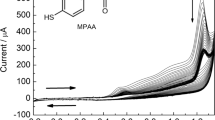Abstract
The electrodeposition of poly(3,4-ethylenedioxythiophene)-tyrosinase (PEDOT-Ty) biocomposite material onto gold electrode has been achieved by means of a sinusoidal voltages (SV) method. The SV method consists in the superimposition of a sinusoidal voltage (sin wave) with fixed frequency and amplitude onto a d.c. potential. The influence of electrochemical parameters like frequency and amplitude of SV signal, d.c. potential value, deposition time, on the electrodeposition process has been investigated. The biocomposite material has been prepared as a thin layer onto quartz crystals coated with gold. The frequency change of the quartz crystal during the electrodeposition of the biocomposite material was recorded simultaneously with the measured current response. The morphology of the deposited PEDOT-Ty coatings was investigated by scanning electron microscopy. The electrochemical behavior of the biocomposite material in aqueous solution was studied by cyclic voltammetry and electrochemical impedance spectroscopy. The use of d.c. potential value of 0.6 V revealed the contribution of the SV component to the electrodeposition process. The PEDOT-Ty modified electrode was used as an electrochemical biosensor in the voltammetric determination of dopamine in the presence of hydroquinone. The analytical performances of the prepared biosensors were also investigated.




Similar content being viewed by others
References
Inzelt G (2012) Conducting polymers. A new era in electrochemistry. In: Scholz F (ed) Monographs in electrochemistry, 2nd edn. Springer, Berlin Heidelberg
Snook GA, Kao P, Best AS (2011) Conducting-polymer-based supercapacitor devices and electrodes. J Power Sources 196:1–12
Lange U, Roznyatovskaya NV, Mirsky VM (2008) Conducting polymers in chemical sensors and arrays. Anal Chim Acta 614:1–26
Ramanavičius A, Ramanavičiene A, Malinauskas A (2006) Electrochemical sensors based on conducting polymer-polypyrrole. Electrochim Acta 51:6025–6037
Gerard M, Chaubey A, Malhotra BD (2002) Application of conducting polymers to biosensors. Biosens Bioelectron 17:345–359
Hatchett DW, Josowicz M (2008) Composites of intrinsically conducting polymers as sensing nanomaterials. Chem Rev 108:746–769
Rajesh AT, Kumar D (2009) Recent progress in the development of nano-structured conducting polymers/nanocomposites for sensor applications. Sensors Actuators B Chem 136:275–286
Ahuja T, Mir IA, Kumar D, Rajesh (2007) Biomolecular immobilization on conducting polymers for biosensing applications. Biomaterials 28:791–805
Wang J, Myung NV, Yun M, Monbouquette HG (2005) Glucose oxidase entrapped in polypyrrole on high-surface-area Pt electrodes: a model platform for sensitive electroenzymatic biosensors. J Electroanal Chem 575:139–146
Cosnier S (1999) Biomolecule immobilization on electrode surfaces by entrapment or attachment to electrochemically polymerized films. Biosens Bioelectron 14:443–456
Reyes De Corcuera JI, Cavalieri RP, Powers JR (2005) Improved platinization conditions produce a 60-fold increase in sensitivity of amperometric biosensors using glucose oxidase immobilized in poly-o-phenylenediamine. J Electroanal Chem 575:229–241
Palomera N, Vera JL, Meléndez E, Ramirez-Vick JE, Tomar MS, Arya SK, Singh SP (2011) Redox active poly(pyrrole-N-ferrocene-pyrrole) copolymer based mediator-less biosensors. J Electroanal Chem 658:33–37
Böyükbayram AE, Kıralp S, Toppare L, Yağcı Y (2006) Preparation of biosensors by immobilization of polyphenol oxidase in conducting copolymers and their use in determination of phenolic compounds in red wine. Bioelectrochemistry 69:164–171
Lupu S, Lete C, Balaure PC, del Campo FJ, Muñoz FX, Lakard B, Hihn J-Y (2013) In situ electrodeposition of biocomposite materials by sinusoidal voltages on microelectrodes array for tyrosinase based amperometric biosensor development. Sensors Actuators B Chem 181:136–143
Lupu S, Lete C, Balaure PC, Caval DI, Mihailciuc C, Lakard B, Hihn J-Y, del Campo FJ (2013) Development of amperometric biosensors based on nanostructured tyrosinase-conducting polymer composite electrodes. Sensors (Basel) 13:6759–6774
Lupu S, Lete C, del Campo FJ (2015) Dopamine electroanalysis using electrochemical biosensors prepared by a sinusoidal voltages method. Electroanalysis 27:1649–1659
Lete C, Lupu S, Lakard B, Hihn J-Y, del Campo FJ (2015) Multi-analyte determination of dopamine and catechol at single-walled carbon nanotubes – conducting polymer – tyrosinase based electrochemical biosensors. J Electroanal Chem 744:53–61
Kvarnström C, Neugebauer H, Blomquist S, Ahonen HJ, Kankare J, Ivaska A (1999) In situ spectroelectrochemical characterization of poly(3,4-ethylenedioxythiophene). Electrochim Acta 44:2739–2750
Łapkowski M, Proń A (2000) Electrochemical oxidation of poly 3,4-ethylenedioxythiophene – “in situ” conductivity and spectroscopic investigations. Synth Met 110:79–83
Zykwinska A, Domagala W, Pilawa B, Łapkowski M (2005) Electrochemical overoxidation of poly(3,4-ethylenedioxythiophene) – PEDOT studied by means of in situ ESR spectroelectrochemistry. Electrochim Acta 50:1625–1633
Inzelt G (2010) Electrochemical quartz crystal nanobalance. In: Scholz F (ed) Electroanalytical methods, vol 10, 2nd edn. Springer, Berlin, pp. 257–270
Laviron E (1979) The use of linear potential sweep voltammetry and of a.C. Voltammetry for the study of the surface electrochemical reaction of strongly adsorbed systems and of redox modified electrodes. J Electroanal Chem 100:263–270
Zhou LY, Tian RH, Zhi JF (2007) Amperometric biosensor based on tyrosinase immobilized on a boron-doped diamond electrode. Biosens Bioelectron 22:822–828
Perez JPH, Lopez MSP, Cabarcos EL, Ruiz BL (2006) Amperometric tyrosinase biosensor based on polyacrylamide microgels. Biosens Bioelectron 22:429–439
Apetrei IM, Apetrei C (2015) Biosensing application of hybrid thin-film layers-based biosensors. IEEE Sensors J 15:6926–6932
Fritea L, Le Goff A, Putaux JL, Tertis M, Cristea C, Săndulescu R, Cosnier S (2015) Design of a reduced-graphene-oxide composite electrode from an electropolymerizable graphene aqueous dispersion using a cyclodextrin-pyrrole monomer. Application to dopamine biosensing. Electrochim Acta 178:108–112
Sulzbacher Caruso C, Da Cruz VI, Fatibello Filho O (1999) Determination of epinephrine and dopamine in pharmaceutical formulations using a biosensor based on carbon paste modified with crude extract of cara root (Dioscorea bulbifera). Anal Lett 32:39–50
Acknowledgments
This work was supported by a grant from the Romanian National Authority for Scientific Research, CNCS–UEFISCDI, Project number PN-II-ID-PCE-2011-3-0271 (298/06.10.2011).
Author information
Authors and Affiliations
Corresponding author
Additional information
We wish to Professor George Inzelt happiness, good health, and success on this occasion of his 70th birthday.
Electronic supplementary material
ESM 1
(DOC 138 kb)
Rights and permissions
About this article
Cite this article
Lete, C., Berger, D., Matei, C. et al. Electrochemical and microgravimetric studies of poly[3,4-ethylenedioxythiophene]-tyrosinase biocomposite material electrodeposited onto gold electrodes by a sinusoidal voltages method. J Solid State Electrochem 20, 3043–3051 (2016). https://doi.org/10.1007/s10008-016-3270-z
Received:
Revised:
Accepted:
Published:
Issue Date:
DOI: https://doi.org/10.1007/s10008-016-3270-z




